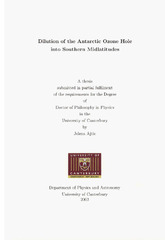Приказ основних података о документу
Dilution of the Antarctic Ozone Hole into Southern Midlatitudes
| dc.contributor.advisor | Heuff, Darlene | |
| dc.contributor.advisor | Connor, Brian | |
| dc.creator | Ajtić, Jelena | |
| dc.date.accessioned | 2022-01-13T11:52:07Z | |
| dc.date.available | 2022-01-13T11:52:07Z | |
| dc.date.issued | 2003 | |
| dc.identifier.uri | https://vet-erinar.vet.bg.ac.rs/handle/123456789/2363 | |
| dc.description.abstract | Reduction in ozone levels in southern midlatitudes, caused by the transport of ozonedepleted air from the Antarctic polar vortex, is examined. The problem is approached from two different, but complementary, directions. First, a case study examining an atypical vertical profile of ozone in December 1998, caused by the presence of vortex air is presented. Second, the overall dilution effect in spring- and summer time in the years 1998, 1999, and 2000 is quantified. In the first approach, an ozonesonde profile over the Network for Detection of Stratospheric Change (NDSC) site at Lauder (45.0° S, 169.7° E), New Zealand, for 24 December 1998 showing atypically low ozone centered around 24 km altitude (600 K potential temperature), is analyzed. The origin of the anomaly is explained using reverse domain filling (RDF) calculations combined with a PV /03 fitting technique applied to ozone measurements from the Polar Ozone and Aerosol Measurement (POAM) III instrument. The RDF calculations for two isentropic surfaces, 550 K and 600 K, show that ozonepoor air from the Antarctic polar vortex reached New Zealand on 24-26 December 1998. The vortex air on the 550 K isentrope originated in the ozone hole region, unlike the air on 600 K, where low ozone values were the result of dynamical effects. High-resolution ozone maps are generated, and their examination shows that the vortex remnant situated above New Zealand was the cause of the altered ozone profile on 24 December. The maps also illustrate mixing of the vortex filaments into southern midlatitudes, whereby the overall midlatitude ozone levels are decreased. In the second approach, to quantify the full impact of the dilution of the Antarctic ozone hole into southern midlatitudes in spring and summer of the years 1998, 1999 and 2000, diabatic RDF calculations are performed for parcels between 30 ° Sand 60 ° S, initialized on a 1 ° longitude by 1 ° latitude grid, on seven potential temperature surfaces, between 400 K and 700 K. In each year, the trajectories are run back to 10 October, at which time the ozone depletion processes in the Antarctic vortex have largely ceased. Two distinct regions in the vortex, the core and the edge region, are taken into account. The reduction in ozone due to the presence of vortex parcels in southern midlatitudes is calculated in the layer between 375 K and 725 K, thus encompassing the stratospheric region where most of ozone depletion occurs and where ozone is most abundant. The calculations are performed under the assumption that the volume mixing ratio of depleted ozone (the difference between undepleted ozone and observed ozone) does not change along the trajectories. To mitigate non-conservation of mass arising from the employment of a Lagrangian model, a scaling method is introduced. The results for the years 1998-2000 show that on average, between 15 October and 15 January of the following year, 17-19% of the midlatitude air parcels originate inside the Antarctic vortex. The corresponding reduction in ozone is 15-18 DU. The reduction caused by the presence of the air parcels originating in the vortex edge region is significant, especially in the early part of the period under examination. The results for four subregions in midlatitudes (spanning longitude regions of 90 0 , starting from 0 0 ) are also presented, and they indicate that, on average, in the region encompassing New Zealand and Australia ozone reduction is less than in other subregions in the months of October and November, but from mid-December to mid-January the reduction is effectively the same in all subregions. Furthermore, tests to examine the sensitivity of the results to uncertainties in the wind fields, and to the choice of the initial day, are performed for the year 1998. The results indicate that the method is more sensitive to the initial conditions, including the size of the vortex and the amount of filamentation, than to introduced perturbations in the winds. The corresponding uncertainties in the midlatitude ozone reduction are 38 % and 5 %, respectively. The uncertainties are generally larger for subregions, and range from 37-65 %, and 4-14 %, respectively. The calculated ozone reduction is compared to the Total Ozone Mapping Spectrometer (TOMS) measurements of ozone column to derive relative changes in the total ozone. The results show that without the dilution effect, ozone levels in southern midlatitudes would be 4-6 % higher during spring- and summertime. Moreover, a comparison of the calculated ozone reduction with ozone levels in 1979 demonstrates that on average, approximately 50-60 % of the change can be attributed to the dilution effect. These results present a lower limit of the impact, as dilution in the lowermost stratosphere and troposphere is not captured in the calculations presented here. | sr |
| dc.language.iso | en | sr |
| dc.publisher | Department of Physics and Astronomy University of Canterbury | sr |
| dc.rights | openAccess | sr |
| dc.rights.uri | https://creativecommons.org/licenses/by-nc-nd/4.0/ | |
| dc.subject | Antarctic Ozone Hole | sr |
| dc.subject | Southern Midlatitudes | sr |
| dc.title | Dilution of the Antarctic Ozone Hole into Southern Midlatitudes | sr |
| dc.type | doctoralThesis | sr |
| dc.rights.license | BY-NC-ND | sr |
| dc.identifier.fulltext | http://veterinar.vet.bg.ac.rs/bitstream/id/6542/ajtic_thesis.pdf | |
| dc.identifier.rcub | https://hdl.handle.net/21.15107/rcub_veterinar_2363 | |
| dc.type.version | publishedVersion | sr |

